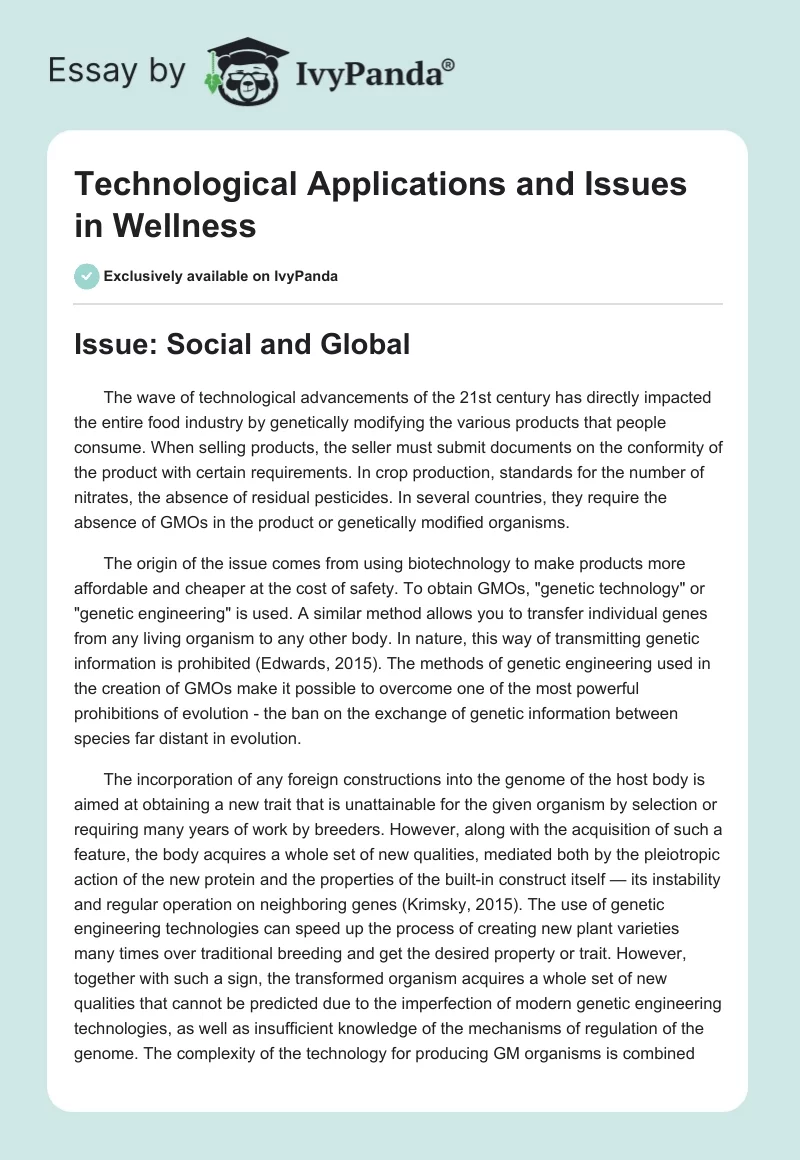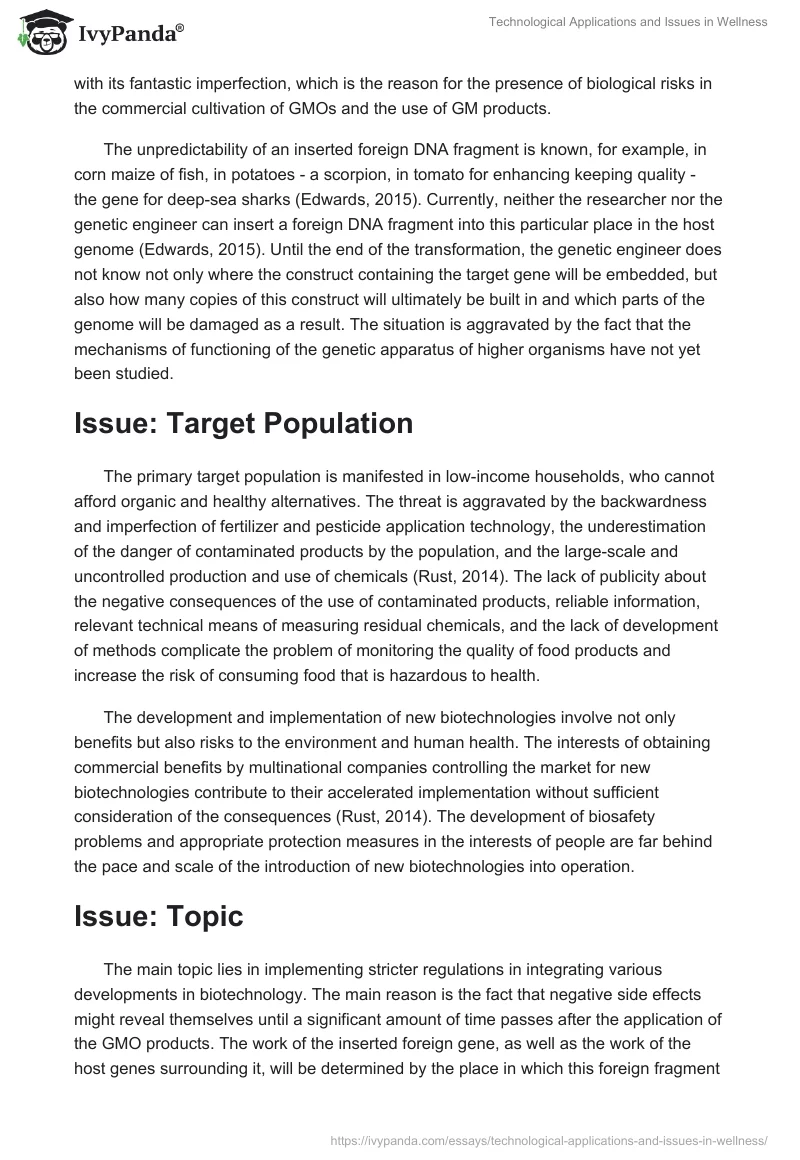Issue: Social and Global
The wave of technological advancements of the 21st century has directly impacted the entire food industry by genetically modifying the various products that people consume. When selling products, the seller must submit documents on the conformity of the product with certain requirements. In crop production, standards for the number of nitrates, the absence of residual pesticides. In several countries, they require the absence of GMOs in the product or genetically modified organisms.
The origin of the issue comes from using biotechnology to make products more affordable and cheaper at the cost of safety. To obtain GMOs, “genetic technology” or “genetic engineering” is used. A similar method allows you to transfer individual genes from any living organism to any other body. In nature, this way of transmitting genetic information is prohibited (Edwards, 2015). The methods of genetic engineering used in the creation of GMOs make it possible to overcome one of the most powerful prohibitions of evolution – the ban on the exchange of genetic information between species far distant in evolution.
The incorporation of any foreign constructions into the genome of the host body is aimed at obtaining a new trait that is unattainable for the given organism by selection or requiring many years of work by breeders. However, along with the acquisition of such a feature, the body acquires a whole set of new qualities, mediated both by the pleiotropic action of the new protein and the properties of the built-in construct itself — its instability and regular operation on neighboring genes (Krimsky, 2015). The use of genetic engineering technologies can speed up the process of creating new plant varieties many times over traditional breeding and get the desired property or trait. However, together with such a sign, the transformed organism acquires a whole set of new qualities that cannot be predicted due to the imperfection of modern genetic engineering technologies, as well as insufficient knowledge of the mechanisms of regulation of the genome. The complexity of the technology for producing GM organisms is combined with its fantastic imperfection, which is the reason for the presence of biological risks in the commercial cultivation of GMOs and the use of GM products.
The unpredictability of an inserted foreign DNA fragment is known, for example, in corn maize of fish, in potatoes – a scorpion, in tomato for enhancing keeping quality – the gene for deep-sea sharks (Edwards, 2015). Currently, neither the researcher nor the genetic engineer can insert a foreign DNA fragment into this particular place in the host genome (Edwards, 2015). Until the end of the transformation, the genetic engineer does not know not only where the construct containing the target gene will be embedded, but also how many copies of this construct will ultimately be built in and which parts of the genome will be damaged as a result. The situation is aggravated by the fact that the mechanisms of functioning of the genetic apparatus of higher organisms have not yet been studied.
Issue: Target Population
The primary target population is manifested in low-income households, who cannot afford organic and healthy alternatives. The threat is aggravated by the backwardness and imperfection of fertilizer and pesticide application technology, the underestimation of the danger of contaminated products by the population, and the large-scale and uncontrolled production and use of chemicals (Rust, 2014). The lack of publicity about the negative consequences of the use of contaminated products, reliable information, relevant technical means of measuring residual chemicals, and the lack of development of methods complicate the problem of monitoring the quality of food products and increase the risk of consuming food that is hazardous to health.
The development and implementation of new biotechnologies involve not only benefits but also risks to the environment and human health. The interests of obtaining commercial benefits by multinational companies controlling the market for new biotechnologies contribute to their accelerated implementation without sufficient consideration of the consequences (Rust, 2014). The development of biosafety problems and appropriate protection measures in the interests of people are far behind the pace and scale of the introduction of new biotechnologies into operation.
Issue: Topic
The main topic lies in implementing stricter regulations in integrating various developments in biotechnology. The main reason is the fact that negative side effects might reveal themselves until a significant amount of time passes after the application of the GMO products. The work of the inserted foreign gene, as well as the work of the host genes surrounding it, will be determined by the place in which this foreign fragment fits (Krimsky, 2015). It means that its position in a new genome for itself, and this position is unpredictable. The consequence of this situation may be a variable change in the functioning of the genetic apparatus, possible disturbances in cellular metabolism, and the synthesis of toxic or allergenic compounds previously not characteristic of this organism.
Violation of the stability of the genome and change in its functioning due to the transfer of foreign information in the form of a DNA fragment is directly related to the pleiotropic effect of the built-in gene, as well as with the phenomenon of dedifferentiation of cells in vitro during the production of GMOs. All these data indicate that GMOs are sources of serious biological and environmental risks (Krimsky, 2015). The widespread use of GMOs and food derived from them is permissible only when the manufacturer provides comprehensive evidence of their complete biological and environmental safety.
References
Edwards, S. (2015). Avoiding genetically modified foods in GMO Ground Zero: A reflective self-narrative. Journal of Health Psychology, 20(5), 500-510.
Krimsky, S. (2015). An illusory consensus behind GMO health assessment. Science, Technology, & Human Values, 40(6), 883-914.
Rust, R. (2014). Nutrition controversies: Keeping things in perspective. American Journal of Lifestyle Medicine, 8(5), 313-317.


